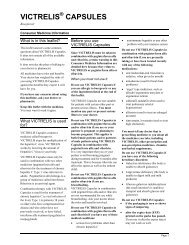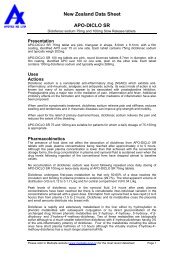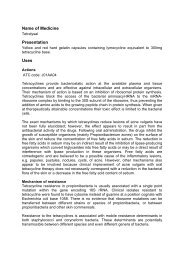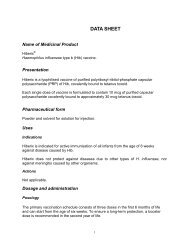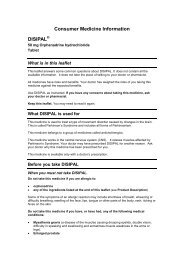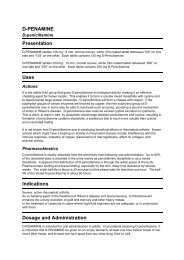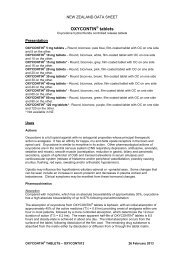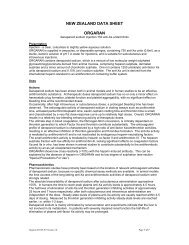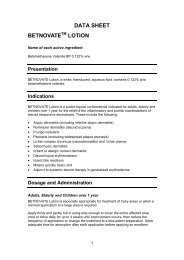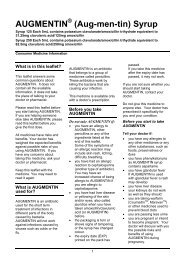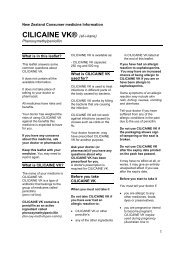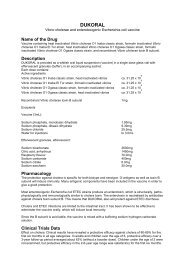Hysite Eye Drops - Medsafe
Hysite Eye Drops - Medsafe
Hysite Eye Drops - Medsafe
You also want an ePaper? Increase the reach of your titles
YUMPU automatically turns print PDFs into web optimized ePapers that Google loves.
<strong>Hysite</strong> <strong>Eye</strong> <strong>Drops</strong><br />
Latanoprost<br />
Consumer Medicine Information<br />
What is in this leaflet<br />
This leaflet answers some common<br />
questions about <strong>Hysite</strong>. It does not<br />
contain all the available information. It<br />
does not take the place of talking to<br />
your doctor or pharmacist.<br />
All medicines have risks and benefits.<br />
Your doctor has weighed the risks of<br />
you using <strong>Hysite</strong> against the benefits it<br />
is expected to have for you.<br />
If you have any concerns about using<br />
this medicine, ask your doctor or<br />
pharmacist.<br />
Keep this leaflet with the medicine.<br />
You may need to read it again.<br />
What <strong>Hysite</strong> is used for<br />
<strong>Hysite</strong> is used to lower raised pressure<br />
in the eye and to treat glaucoma.<br />
Glaucoma is a condition in which the<br />
pressure of fluid in the eye may be<br />
high. However, some people with<br />
glaucoma may have normal eye<br />
pressure.<br />
Glaucoma is usually caused by a build<br />
up of the fluid which flows through the<br />
eye. This build up occurs because the<br />
fluid drains out of your eye more<br />
slowly than it is being pumped in.<br />
Since new fluid continues to enter the<br />
eye, joining the fluid already there, the<br />
pressure continues to rise. This raised<br />
pressure may damage the back of the<br />
eye resulting in gradual loss of sight.<br />
Damage can progress so slowly that the<br />
person is not aware of this gradual loss<br />
of sight. Sometimes even normal eye<br />
pressure is associated with damage to<br />
the back of the eye.<br />
There are usually no symptoms of<br />
glaucoma. If glaucoma is not treated it<br />
can lead to serious problems, including<br />
total blindness. In fact, untreated<br />
glaucoma is one of the most common<br />
causes of blindness.<br />
<strong>Hysite</strong> belongs to a family of medicines<br />
called prostaglandin agonists.<br />
It lowers the pressure in the eye by<br />
allowing more fluid to flow out from<br />
within your eye.<br />
Although <strong>Hysite</strong> helps control your<br />
glaucoma it does not cure it. So you<br />
must keep using it until your doctor<br />
tells you to stop.<br />
<strong>Hysite</strong> is used, either alone or in<br />
combination with other eye medicines,<br />
to lower raised pressure within your<br />
eye.<br />
Ask your doctor if you have any<br />
questions about why <strong>Hysite</strong> has been<br />
prescribed for you.<br />
Your doctor may have prescribed it for<br />
another reason.<br />
<strong>Hysite</strong> is not addictive.<br />
<strong>Hysite</strong> is not recommended for use in<br />
children. The safety and effectiveness<br />
of <strong>Hysite</strong> in children have not been<br />
established.<br />
Before you use <strong>Hysite</strong><br />
When you must not use it<br />
Do not use <strong>Hysite</strong> if:<br />
you have an allergy to <strong>Hysite</strong> or<br />
any of the ingredients listed at<br />
the end of this leaflet<br />
Symptoms of an allergic reaction<br />
may include:<br />
asthma, wheezing or shortness<br />
of breath<br />
swelling of the face, lips or<br />
tongue which may cause<br />
difficulty in swallowing or<br />
breathing<br />
hives, itching or skin rash<br />
fainting<br />
the bottle or packaging shows<br />
signs of tampering<br />
the expiry date on the pack has<br />
passed.<br />
If you use this medicine after the expiry<br />
date has passed, it may not work.<br />
If you are not sure whether you<br />
should start using <strong>Hysite</strong>, talk to<br />
your doctor.<br />
Before you start to use it<br />
Tell your doctor if:<br />
1. you have had an allergy to any<br />
other medicines or any other<br />
substances, such as foods,<br />
preservatives or dyes<br />
2. you are pregnant or intend to<br />
become pregnant<br />
Your doctor will discuss the<br />
possible risks and benefits of using<br />
<strong>Hysite</strong> during pregnancy.<br />
3. you are breast-feeding or intend<br />
to breast-feed<br />
Your doctor will discuss the<br />
possible risks and benefits of using<br />
<strong>Hysite</strong> when breast-feeding.<br />
4. you have or have had any<br />
medical conditions such as<br />
severe asthma, or any other<br />
types of glaucoma or eye<br />
conditions<br />
If you have not told your doctor<br />
about any of the above, tell him or<br />
her before you use <strong>Hysite</strong>.<br />
Taking other medicines<br />
Tell your doctor or pharmacist if you<br />
are taking any other medicines,<br />
including any that you buy without a<br />
prescription from your pharmacy,<br />
supermarket or health food shop.
Some medicines and <strong>Hysite</strong> may<br />
interfere with each other. These<br />
include:<br />
eye drops which contain an<br />
ingredient called thiomersal. If<br />
using such eye drops as well as<br />
<strong>Hysite</strong>, you should wait at least 5<br />
minutes between using these eye<br />
drops and <strong>Hysite</strong>.<br />
some other eye drops that contain<br />
a prostaglandin. The use of two or<br />
more prostaglandin eye drops at<br />
the same time is not recommended.<br />
How to use <strong>Hysite</strong><br />
Use <strong>Hysite</strong> only when prescribed by<br />
your doctor.<br />
Follow all directions given to you by<br />
your doctor carefully.<br />
They may differ from the information<br />
contained in this leaflet.<br />
If you are being changed from one<br />
eye drop to another, follow your<br />
doctor’s instructions carefully as to<br />
when to stop the old drops and when<br />
to start the new drops.<br />
How much to use<br />
The usual dose of <strong>Hysite</strong> is one drop<br />
into the affected eye, or eyes, once<br />
daily.<br />
Use <strong>Hysite</strong> every day, at about the<br />
same time each day, preferably in<br />
the evening, unless your doctor tells<br />
you otherwise.<br />
Using your eye drops at the same time<br />
each day will have the best effect on<br />
your eye pressure. It will also help you<br />
remember when to use the eye drops.<br />
How to use it<br />
If you are wearing soft contact<br />
lenses, remove them before putting<br />
the drops in your eye.<br />
The preservative in <strong>Hysite</strong><br />
(benzalkonium chloride) may be<br />
deposited in soft contact lenses. You<br />
can put your soft contact lenses back<br />
into your eyes 15 minutes after you<br />
have used <strong>Hysite</strong>.<br />
If using other eye drops in addition<br />
to <strong>Hysite</strong>, wait at least 5 minutes<br />
before putting any other drops in<br />
your eye(s).<br />
Be careful not to touch the dropper<br />
tip against your eye, eyelid or<br />
anything else. Touching the dropper<br />
tip against something may contaminate<br />
the eye drops and give you an eye<br />
infection.<br />
You may find it easier to put drops in<br />
your eye while you are sitting or lying<br />
down.<br />
1. Wash your hands well with soap<br />
and water.<br />
2. Twist off the protective overcap<br />
from the bottle.<br />
3. Unscrew the inner cap.<br />
4. Use your finger to gently pull<br />
down the lower eyelid of your<br />
affected eye.<br />
5. Tilt your head back and look up.<br />
6. Place the tip of the bottle close to<br />
but not touching your eye.<br />
Squeeze the bottle gently so that<br />
only one drop goes into your eye,<br />
then release the lower eyelid.<br />
Close your eye. Do not blink or<br />
rub your eye.<br />
7. While your eye is closed, place<br />
your index finger against the inside<br />
corner of your eye and press<br />
against your nose for about two<br />
minutes. This will help to stop the<br />
medicine from draining through<br />
the tear duct to the nose and throat,<br />
from where it can be absorbed into<br />
other parts of your body. Ask your<br />
doctor for more specific<br />
instructions on this technique.<br />
8. Screw the inner cap back on the<br />
bottle.<br />
9. Wash your hands again with soap<br />
and water to remove any residue<br />
You may feel a slight burning sensation<br />
in the eye shortly after using the eye<br />
drops.<br />
If this persists, or is very<br />
uncomfortable, contact your doctor<br />
or pharmacist.<br />
How long to use it<br />
Continue using <strong>Hysite</strong> every day for<br />
as long as your doctor prescribes.<br />
<strong>Hysite</strong> helps control your condition but<br />
does not cure it.<br />
If you forget to use it<br />
If you miss a dose, skip the dose you<br />
missed and take your next dose when<br />
you are meant to.<br />
If you are not sure whether to skip the<br />
dose, talk to your doctor or pharmacist.<br />
Do not use double the amount to<br />
make up for the dose that you<br />
missed.<br />
If you use too much (overdose)<br />
If you accidentally put several drops<br />
in your eye, immediately rinse your<br />
eye with warm water.<br />
If you think that you or anyone else<br />
may have swallowed <strong>Hysite</strong>,<br />
immediately telephone your doctor<br />
or the New Zealand National Poisons<br />
Information Centre (telephone<br />
0800 POISON or 0800 764 766) for<br />
advice, or go to Accident and<br />
Emergency at your nearest hospital.<br />
Do this even if there are no signs of<br />
discomfort or poisoning.<br />
While you are using<br />
<strong>Hysite</strong><br />
Things you must do<br />
To make sure <strong>Hysite</strong> is working<br />
properly, have your eye pressure<br />
checked regularly.<br />
Have your eyes checked regularly<br />
for any other changes, including a<br />
change in eye colour.<br />
A slow change in eye colour, which<br />
may be permanent, has been reported<br />
to occur in some patients who use
<strong>Hysite</strong>. Your doctor will decide<br />
whether you should continue using<br />
<strong>Hysite</strong>.<br />
If you develop an eye infection,<br />
receive an eye injury, or have eye<br />
surgery tell your doctor.<br />
Your doctor may tell you to use a new<br />
container of <strong>Hysite</strong> because of possible<br />
contamination of the old one, or may<br />
advise you to stop your treatment with<br />
<strong>Hysite</strong>.<br />
If you become pregnant while using<br />
<strong>Hysite</strong> tell your doctor immediately.<br />
If you are about to be started on any<br />
new medicine tell your doctor and<br />
pharmacist that you are using<br />
<strong>Hysite</strong>.<br />
Tell all doctors and pharmacists who<br />
are treating you that you are using<br />
<strong>Hysite</strong>.<br />
Things you must not do<br />
Do not give <strong>Hysite</strong> to anyone else,<br />
even if they have the same condition<br />
as you.<br />
Do not use this medicine to treat any<br />
other complaints unless your doctor<br />
tells you to.<br />
Do not stop using <strong>Hysite</strong> without<br />
first talking to your doctor.<br />
If you stop using your eye drops, your<br />
eye pressures may rise again and<br />
damage to your eye may occur.<br />
Things to be careful of<br />
Be careful driving or operating<br />
machinery until you know how<br />
<strong>Hysite</strong> affects you.<br />
<strong>Hysite</strong> generally does not cause any<br />
problems with your ability to drive a<br />
car or operate machinery. However, it<br />
may cause blurred vision in some<br />
people. Make sure you know how you<br />
react to <strong>Hysite</strong> or that your vision is<br />
clear before driving a car or operating<br />
machinery.<br />
Side effects<br />
Check with your doctor as soon as<br />
possible if you have any problems<br />
while taking <strong>Hysite</strong>, even if you do<br />
not think the problems are connected<br />
with the medicine or are not listed in<br />
this leaflet.<br />
Like other medicines, <strong>Hysite</strong> can cause<br />
some side effects. If they occur, most<br />
are likely to be minor and temporary.<br />
However, some may be serious and<br />
need medical attention.<br />
Ask your doctor or pharmacist to<br />
answer any questions you may have.<br />
Tell your doctor if you notice any of<br />
the following and they worry you:<br />
a slow change in eye colour over a<br />
period of time. The iris may<br />
become more brown in colour and<br />
appear darker. This change may<br />
be permanent and more noticeable<br />
if you are only being treated in one<br />
eye<br />
blurred vision, double vision or<br />
other visual problems<br />
irritation or feeling of having<br />
something in the eye. This may be<br />
worse during the first two or three<br />
days of using <strong>Hysite</strong>.<br />
eye pain<br />
redness, burning or watering of the<br />
eye/s<br />
discharge, itching of the eye/s,<br />
crusty eyelashes<br />
darkening, thickening, lengthening<br />
or an increase in the number of eye<br />
lashes and the fine hair on the<br />
eyelids<br />
misdirected eyelashes sometimes<br />
causing eye irritation<br />
darkening of the skin of the eyelids<br />
crusting, redness, thickening,<br />
itching or burning of the eyelids<br />
sensitivity to light<br />
skin rash<br />
headache<br />
muscle/joint pain<br />
painful, urgent or frequent<br />
urination.<br />
If any of the following happen, stop<br />
using <strong>Hysite</strong> and tell your doctor<br />
immediately or go to Accident and<br />
Emergency at your nearest hospital:<br />
wheezing, difficulty in breathing<br />
(asthma or worsening of asthma)<br />
shortness of breath<br />
chest pain<br />
dizziness<br />
swelling of the face, lips, mouth,<br />
tongue or throat which may cause<br />
difficulty in swallowing or<br />
breathing.<br />
These are rare but serious side effects.<br />
You may need urgent medical<br />
attention.<br />
Tell your doctor if you notice any<br />
other effects. Other side effects not<br />
listed above may also occur in some<br />
patients.<br />
Do not be alarmed by this list of<br />
possible side effects. You may not<br />
experience any of them.<br />
After using <strong>Hysite</strong><br />
Storage<br />
Keep your eye drops in a safe place<br />
away from the sight and reach of<br />
children.<br />
A locked cupboard at least one-and-ahalf<br />
metres above the ground is a good<br />
place to store medicines.<br />
Before opening <strong>Hysite</strong>, keep the<br />
bottle in its box in a refrigerator<br />
(2 o C - 8 o C) protected from light.<br />
After opening <strong>Hysite</strong>, keep the bottle<br />
in its box in a cool place where the<br />
temperature stays below 25 o C, but<br />
do not refrigerate. Keep the box<br />
properly closed and protected from<br />
light.<br />
Do not store <strong>Hysite</strong> or any other<br />
medicine in the bathroom or near a<br />
sink. Do not leave it in the car or on<br />
window sills. Do not carry the eye<br />
drops in pockets of your clothes.
Heat and dampness can destroy some<br />
medicines.<br />
Put the top back on the bottle right<br />
away after use to avoid<br />
contaminating the eye drops.<br />
Disposal<br />
Write the date on the bottle when<br />
you open the eye drops and throw<br />
out any remaining solution after four<br />
weeks.<br />
Open a new bottle every 4 weeks.<br />
<strong>Eye</strong> drops contain a preservative which<br />
helps prevent germs growing in the<br />
solution for the first four weeks after<br />
opening the bottle. After this time<br />
there is a greater risk that the drops<br />
may become contaminated and cause<br />
an eye infection.<br />
If your doctor tells you to stop using<br />
the eye drops or they have passed<br />
their expiry date, ask your<br />
pharmacist what to do with any<br />
remaining solution.<br />
Product description<br />
What it looks like<br />
<strong>Hysite</strong> eye drops come in a plastic<br />
bottle with a dropper and screw cap<br />
inside a protective overcap. Remove<br />
this overcap before use.<br />
When you first receive your <strong>Hysite</strong><br />
bottle, it will appear half full. This<br />
corresponds to 2.5 mL of eye drop<br />
solution, giving a minimum of<br />
80 drops. This volume is enough to<br />
last 4 weeks if used in both eyes.<br />
Ingredients<br />
The active ingredient in <strong>Hysite</strong> eye<br />
drops is latanoprost. Each 1 mL of<br />
<strong>Hysite</strong> contains 50 micrograms of<br />
latanoprost. Each drop contains about<br />
1.5 micrograms of latanoprost.<br />
<strong>Hysite</strong> eye drops also contain<br />
sodium chloride<br />
monobasic sodium phosphate<br />
dibasic anhydrous sodium<br />
phosphate<br />
water for injections<br />
benzalkonium chloride (as a<br />
preservative).<br />
Supplier<br />
<strong>Hysite</strong> is supplied in New Zealand by:<br />
Pfizer New Zealand Ltd<br />
PO Box 3998<br />
Auckland, New Zealand<br />
Toll Free number: 0800 736 363<br />
For more information about glaucoma,<br />
contact Glaucoma New Zealand<br />
(telephone 09 373 8779).<br />
This leaflet was prepared in October<br />
2011.<br />
Pfizer Australia Pty Ltd<br />
Registered Trademark



